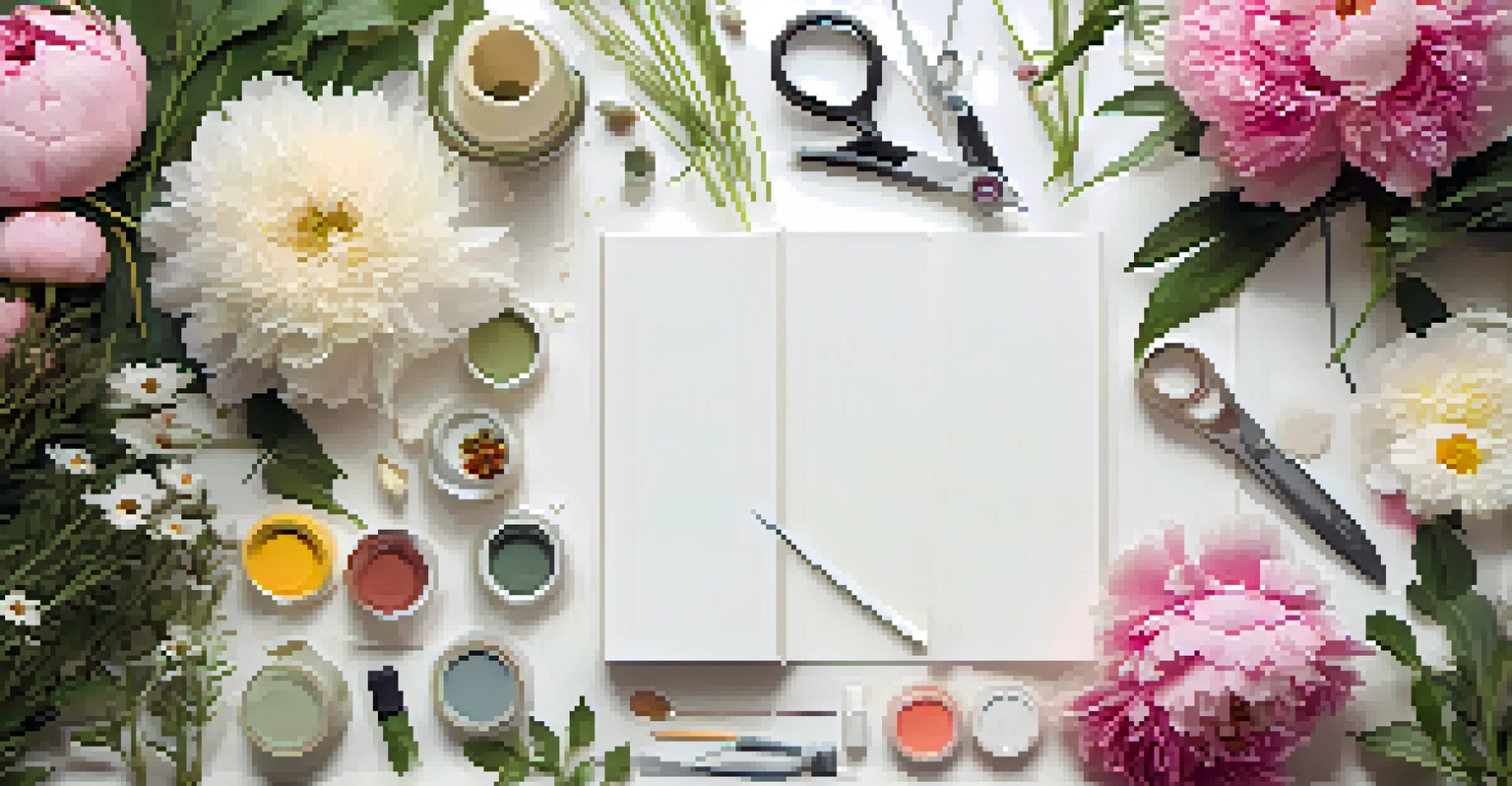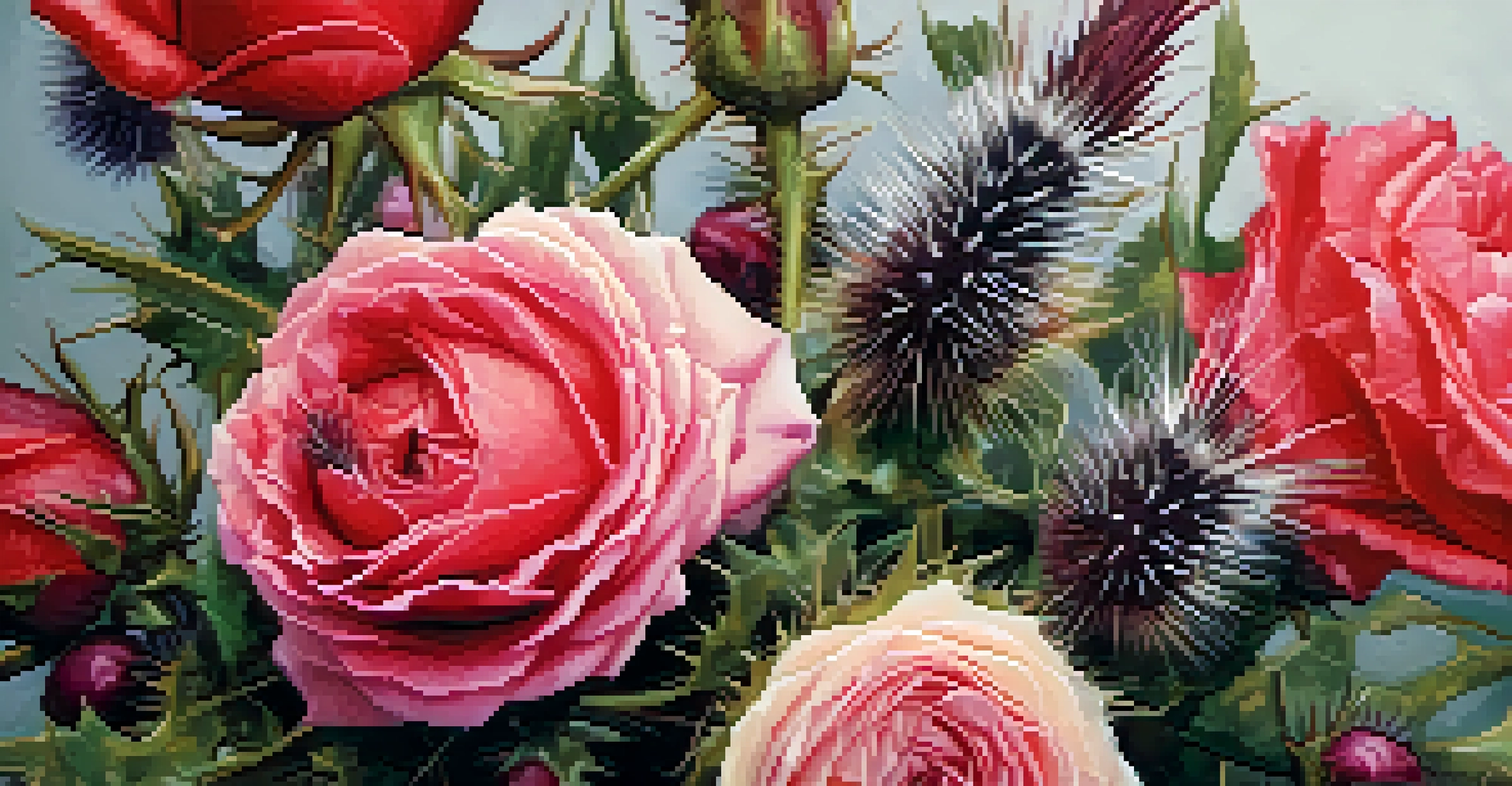Essential Floral Arranging Techniques for Beginners to Master

Understanding the Basics of Floral Design
Before diving into floral arranging, it's crucial to grasp the fundamentals of design. Floral design is about creating a visual balance and harmony using different elements like color, shape, and texture. Think of it as painting a picture, where flowers are your colors that need to be arranged thoughtfully.
Flowers are the music of the ground. From earth's lips they speak.
One essential principle is the 'Rule of Threes.' This rule states that you should group flowers in odd numbers—three, five, or seven—to create a more natural and appealing look. Odd numbers often draw the eye and create more interest than even ones, making your arrangement feel dynamic and lively.
As you start, experiment with various flower types and colors. Understanding their characteristics will help you make better choices in your arrangements. Remember, it's all about finding the right balance so that your design feels cohesive and aesthetically pleasing.
Choosing the Right Flowers for Your Arrangement
Selecting the right flowers is a crucial step in floral arranging. Consider the occasion and the message you want to convey; different flowers symbolize various emotions and meanings. For instance, roses often represent love, while sunflowers symbolize happiness and warmth.

When choosing flowers, also think about their size, shape, and texture. Mixing large blooms with smaller ones adds depth to your arrangement, while varying textures can create visual interest. Don’t hesitate to include greenery or filler flowers to enhance your design and provide contrast.
Master Floral Design Basics
Understanding fundamental principles like the 'Rule of Threes' enhances the visual appeal of your arrangements.
Seasonality plays a significant role in flower selection as well. Using seasonal blooms not only ensures freshness but can also save you money. Plus, seasonal flowers often reflect the beauty of their time, making your arrangements feel more connected to nature.
Essential Tools for Floral Arranging
Having the right tools can make floral arranging much easier and more enjoyable. Start with basic items like sharp floral scissors or a knife, which will help you cut stems cleanly and effectively. A sturdy pair of scissors can make a world of difference in your overall experience.
Design is not just what it looks like and feels like. Design is how it works.
Floral foam, or oasis, is another essential tool that helps keep your flowers hydrated and in place. When using floral foam, soak it in water before arranging your flowers, ensuring that your blooms will last longer. Additionally, consider investing in a floral tape to secure your stems and create a sturdy base.
Lastly, don't overlook the importance of a good vase. The right vessel can enhance your arrangement and provide the necessary support for your flowers. Choose a vase that complements your design style and the types of flowers you’re using for a polished look.
The Importance of Color Theory in Floral Design
Color theory is a vital aspect of floral design that can elevate your arrangements significantly. Understanding the color wheel can help you choose flowers that complement or contrast beautifully with one another. For instance, pairing complementary colors like purple and yellow can create a vibrant, eye-catching display.
Consider using analogous colors (those next to each other on the color wheel) for a more harmonious look. This approach can create a soothing effect, perfect for events like weddings or quiet gatherings. Think of it as creating a mood with your flowers, where every color plays a role.
Select Flowers Wisely
Choosing the right flowers based on occasion, symbolism, and seasonality is key to creating meaningful arrangements.
Experimenting with different color combinations can lead to delightful surprises. Don’t be afraid to play around with hues and shades, as this experimentation is often where your unique style will shine through. Over time, you'll develop a keen eye for what works together.
Creating Balance and Proportion in Arrangements
Balance and proportion are key principles of floral arranging that help create visually appealing designs. Balance refers to the distribution of visual weight in your arrangement. You can achieve balance through symmetrical (evenly distributed) or asymmetrical (unevenly distributed) designs, depending on the look you want.
Proportion deals with the size relationships between different flowers and elements in your arrangement. For example, a large bloom should be balanced with smaller flowers and greenery to create a harmonious flow. Always step back and assess your design from a distance to ensure everything feels cohesive.
Remember, achieving balance and proportion is about using your intuition as much as following rules. As you gain experience, you'll develop a better sense of what looks right. Don't be afraid to trust your instincts and make adjustments as needed!
Incorporating Texture into Your Floral Arrangements
Texture adds depth and interest to floral arrangements, making them more engaging to the eye. When selecting flowers, think about mixing different textures; for example, pairing velvety roses with spiky thistles can create a stunning contrast. This variety will draw attention and keep viewers intrigued.
In addition to flowers, consider incorporating other elements like berries, branches, or even grasses to enhance texture. These additions not only provide visual interest but can also create a more natural look, reminiscent of wildflower arrangements found in nature.
Caring for Your Arrangements
Proper maintenance, including regular water changes and stem trimming, ensures your floral creations stay vibrant longer.
Experimenting with texture is a fun way to develop your style as a floral designer. Don't shy away from trying unconventional combinations—sometimes, the most unexpected textures can lead to the most breathtaking arrangements.
Caring for Your Floral Arrangements
After crafting your beautiful floral arrangement, it's crucial to care for it to ensure longevity. Start by trimming the stems at an angle before placing them in water. This practice allows for better water absorption, keeping your blooms fresh and vibrant for longer.
Change the water every few days and add floral preservative if possible. This simple step can help prevent bacteria growth and extend the life of your flowers. Also, be mindful of the arrangement's placement; avoiding direct sunlight and drafts will help maintain its freshness.

Lastly, keep an eye on wilting flowers. If you notice any blooms starting to fade, gently remove them to allow the remaining flowers to shine. Regular maintenance will keep your arrangement looking its best, providing joy for as long as possible.